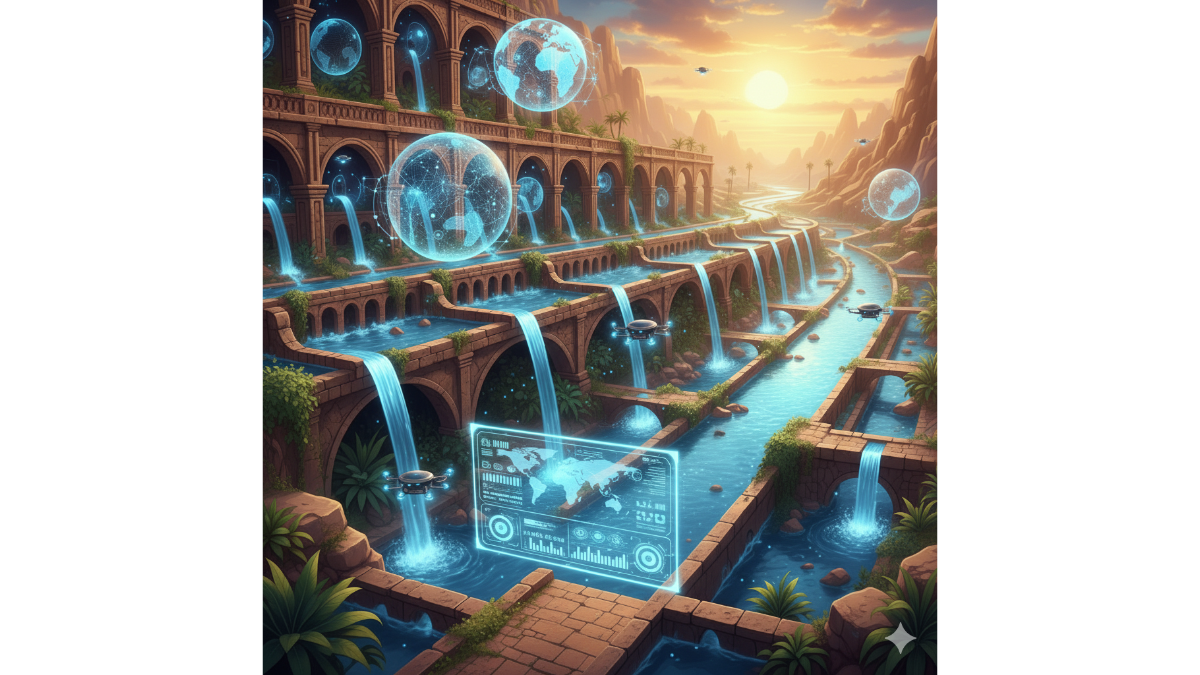Can Ancient Engineering and Artificial Intelligence Help us solve the Fresh Water Crisis? Yes.

Beyond just conservation: Solving the freshwater crisis requires a sustainable economy.
For millennia, human ingenuity has defied the harshest environments. Civilizations have flourished in some of the most arid regions on Earth, not by magic, but by mastering sophisticated techniques for water management. They continue to survive and even thrive, challenging our modern assumptions about scarcity. Now is the time to reignite that ancient wisdom and marry it with cutting-edge technology. We can begin by specifically examining the Southwestern part of the United States, a region encompassing seven of the most severely affected states, as well as vital parts of Mexico, where the need is immediate and profound. Now, imagine if Artificial Intelligence (AI) could act as a guide, helping to rediscover and optimize forgotten methods, assisting deserts in becoming greener, and transforming barren landscapes into vibrant ecosystems.
There are innovative, often overlooked methods that can be employed if there is a collective will to do so. Solutions other than monumental dams or vast desalination plants. Small, localized remedies from around the world can provide the incremental yet crucial steps required to make this a resounding success. We must foster a mindset where every drop counts and every community feels empowered to contribute to a larger, sustainable water future.
Consider the recent triumph of the TeamWater campaign. In August 2025, through a concerted global effort, TeamWater successfully raised an astonishing $40 million, providing fresh water to 2 million people worldwide. This monumental achievement is not just about fundraising; it was a powerful testament to what is possible when people unite around a shared vision. Teacher Dale personally experienced the impact of this collective drive through content creation and firsthand witnessing of how dedication can propel a cause to victory. TeamWater proved that We Did It! is not just a slogan, but an achievable reality.
Why not take this incredible momentum and effort to the next level? The TeamWater success story provides a powerful blueprint: identify a critical need, rally support, leverage modern communication, and achieve tangible results. Now, this same energy and spirit must be applied to a broader, systemic challenge.
There is a stark scientific reality: our planet, often referred to as the Blue Marble, is composed of almost 70% water, yet less than 1% of it can be readily used for drinking water. This statistic, while sobering, often overshadows another crucial fact. There is enough water vapor in the atmosphere right now to provide an abundance of fresh water for all the people on Earth. The challenge is more than the absence of water, but rather our inability to efficiently and sustainably capture, purify, and distribute it. This is where the synergy between ancient techniques and modern AI becomes not just an idea, but an imperative. Imagine AI models analyzing historical climate patterns, ancient irrigation systems, and local ecological data to identify optimal locations for dew harvesting, fog nets, or even revitalized underground aqueducts.
As someone who grew up in California, a state that has been perpetually grappling with drought, and currently lives in Colorado, the importance of responsible water usage and conservation is understood through personal experience. These aren't abstract concepts but daily realities. What tangible steps can be taken by individuals, communities, and industries to help conserve water and become more accountable in its use? It starts with education, but it quickly moves to action. Implementing smart irrigation in agriculture, promoting water-efficient household appliances, advocating for rainwater harvesting systems in urban areas, and simply being mindful of daily consumption habits are all crucial. Every household and every business has a role to play in shifting from a culture of consumption to one of conservation and replenishment.
A key, often underestimated, element is the restoration of our natural water infrastructure. Cleaning up existing waterways and actively restoring marshes, wetlands, and mangroves can provide significant additional support to the freshwater supply. These natural systems act as magnificent sponges and filters, purifying water, recharging groundwater, and mitigating the effects of floods and droughts. The technology and ecological understanding to achieve this exist, but there must be a fundamental willingness to prevent harsh chemicals and pollutants from continuously entering these vital waterways.
This is where a sustainable economy can become a powerful catalyst for change. Rather than viewing pollution prevention as a simple cost, businesses across various industries can see it as an opportunity to innovate, create new markets, and become leaders in a growing green sector. Finding alternative, sustainable methods for disposing of toxic waste is not just an environmental responsibility; it’s an opportunity to develop new technologies, generate long-term savings, and build a more resilient brand. With AI, we can model the impact of pollutants, identify sources, and even design cleaner manufacturing processes, proving that environmental responsibility is also a path to profitability. This is not just an ecological plea; it’s an economic imperative and a moral obligation to protect our most precious resource.
Our success with TeamWater was a powerful example of what can be achieved when we focus our collective energy and resources. Now, let’s take that inspiration and apply it to a grander challenge: harnessing ancient wisdom, cutting-edge AI, and collective will to secure freshwater for all, starting with regions like the American Southwest. The time for innovative solutions is now.
Categories: : Sustainability, Environmental Solutions, Technology & Innovation, Social Impact, Business & Economics
 Dale Snavely
Dale Snavely 